Accounting in Organisations & Society Report - Supplier Analysis
VerifiedAdded on 2021/04/16
|7
|1852
|27
Report
AI Summary
This report analyzes accounting within organizations and its impact on society, focusing on stakeholder needs and ethical considerations. It examines the informational needs of shareholders, customers, government bodies, suppliers, and lenders. The report utilizes a balanced scorecard to assess performance, highlighting key metrics for financial, customer, internal processes, and learning & growth perspectives. A cost-benefit analysis is conducted to evaluate two suppliers, emphasizing the importance of ethical practices and long-term sustainability. The report also explores the stages of Life Cycle Assessment (LCA), specifically inventory analysis and impact assessment, using the example of a T-shirt to illustrate environmental and social consequences of unethical sourcing. Finally, the report discusses the clothing industry's practices, particularly outsourcing and child labor issues, emphasizing the need for sustainable and ethical business practices to generate long-term value for shareholders. The report references key academic articles and industry reports.
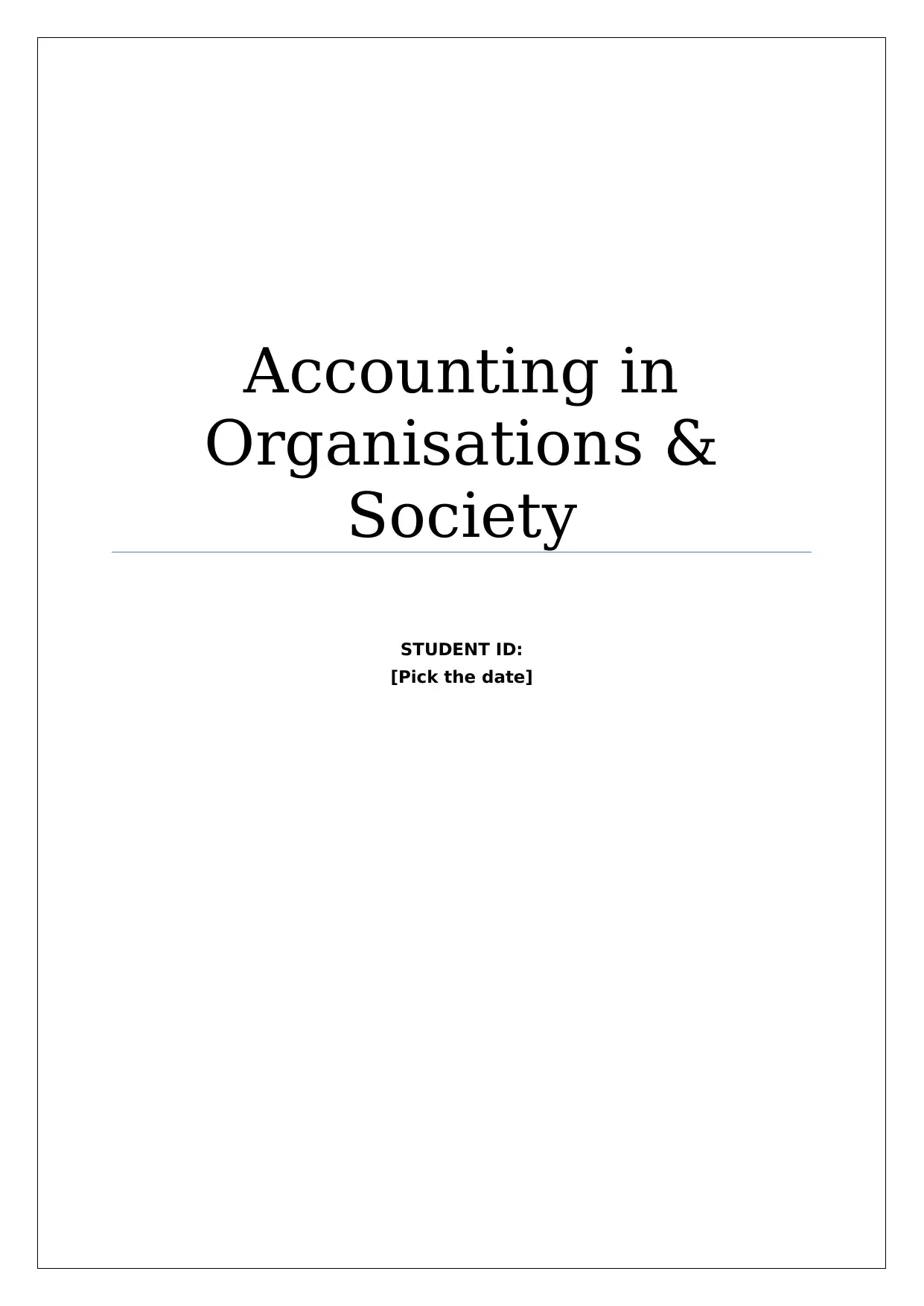
Accounting in
Organisations &
Society
STUDENT ID:
[Pick the date]
Organisations &
Society
STUDENT ID:
[Pick the date]
Paraphrase This Document
Need a fresh take? Get an instant paraphrase of this document with our AI Paraphraser
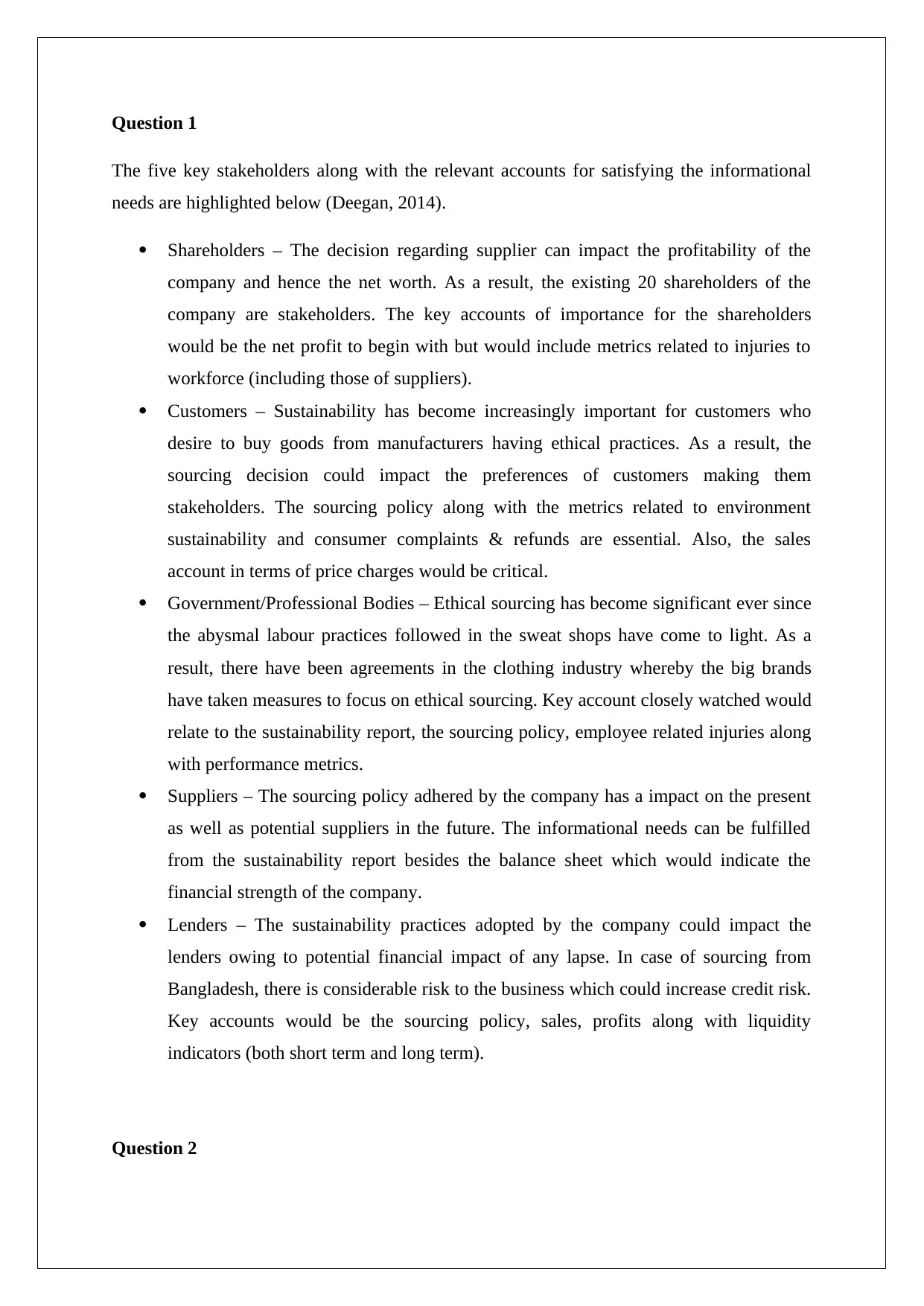
Question 1
The five key stakeholders along with the relevant accounts for satisfying the informational
needs are highlighted below (Deegan, 2014).
Shareholders – The decision regarding supplier can impact the profitability of the
company and hence the net worth. As a result, the existing 20 shareholders of the
company are stakeholders. The key accounts of importance for the shareholders
would be the net profit to begin with but would include metrics related to injuries to
workforce (including those of suppliers).
Customers – Sustainability has become increasingly important for customers who
desire to buy goods from manufacturers having ethical practices. As a result, the
sourcing decision could impact the preferences of customers making them
stakeholders. The sourcing policy along with the metrics related to environment
sustainability and consumer complaints & refunds are essential. Also, the sales
account in terms of price charges would be critical.
Government/Professional Bodies – Ethical sourcing has become significant ever since
the abysmal labour practices followed in the sweat shops have come to light. As a
result, there have been agreements in the clothing industry whereby the big brands
have taken measures to focus on ethical sourcing. Key account closely watched would
relate to the sustainability report, the sourcing policy, employee related injuries along
with performance metrics.
Suppliers – The sourcing policy adhered by the company has a impact on the present
as well as potential suppliers in the future. The informational needs can be fulfilled
from the sustainability report besides the balance sheet which would indicate the
financial strength of the company.
Lenders – The sustainability practices adopted by the company could impact the
lenders owing to potential financial impact of any lapse. In case of sourcing from
Bangladesh, there is considerable risk to the business which could increase credit risk.
Key accounts would be the sourcing policy, sales, profits along with liquidity
indicators (both short term and long term).
Question 2
The five key stakeholders along with the relevant accounts for satisfying the informational
needs are highlighted below (Deegan, 2014).
Shareholders – The decision regarding supplier can impact the profitability of the
company and hence the net worth. As a result, the existing 20 shareholders of the
company are stakeholders. The key accounts of importance for the shareholders
would be the net profit to begin with but would include metrics related to injuries to
workforce (including those of suppliers).
Customers – Sustainability has become increasingly important for customers who
desire to buy goods from manufacturers having ethical practices. As a result, the
sourcing decision could impact the preferences of customers making them
stakeholders. The sourcing policy along with the metrics related to environment
sustainability and consumer complaints & refunds are essential. Also, the sales
account in terms of price charges would be critical.
Government/Professional Bodies – Ethical sourcing has become significant ever since
the abysmal labour practices followed in the sweat shops have come to light. As a
result, there have been agreements in the clothing industry whereby the big brands
have taken measures to focus on ethical sourcing. Key account closely watched would
relate to the sustainability report, the sourcing policy, employee related injuries along
with performance metrics.
Suppliers – The sourcing policy adhered by the company has a impact on the present
as well as potential suppliers in the future. The informational needs can be fulfilled
from the sustainability report besides the balance sheet which would indicate the
financial strength of the company.
Lenders – The sustainability practices adopted by the company could impact the
lenders owing to potential financial impact of any lapse. In case of sourcing from
Bangladesh, there is considerable risk to the business which could increase credit risk.
Key accounts would be the sourcing policy, sales, profits along with liquidity
indicators (both short term and long term).
Question 2
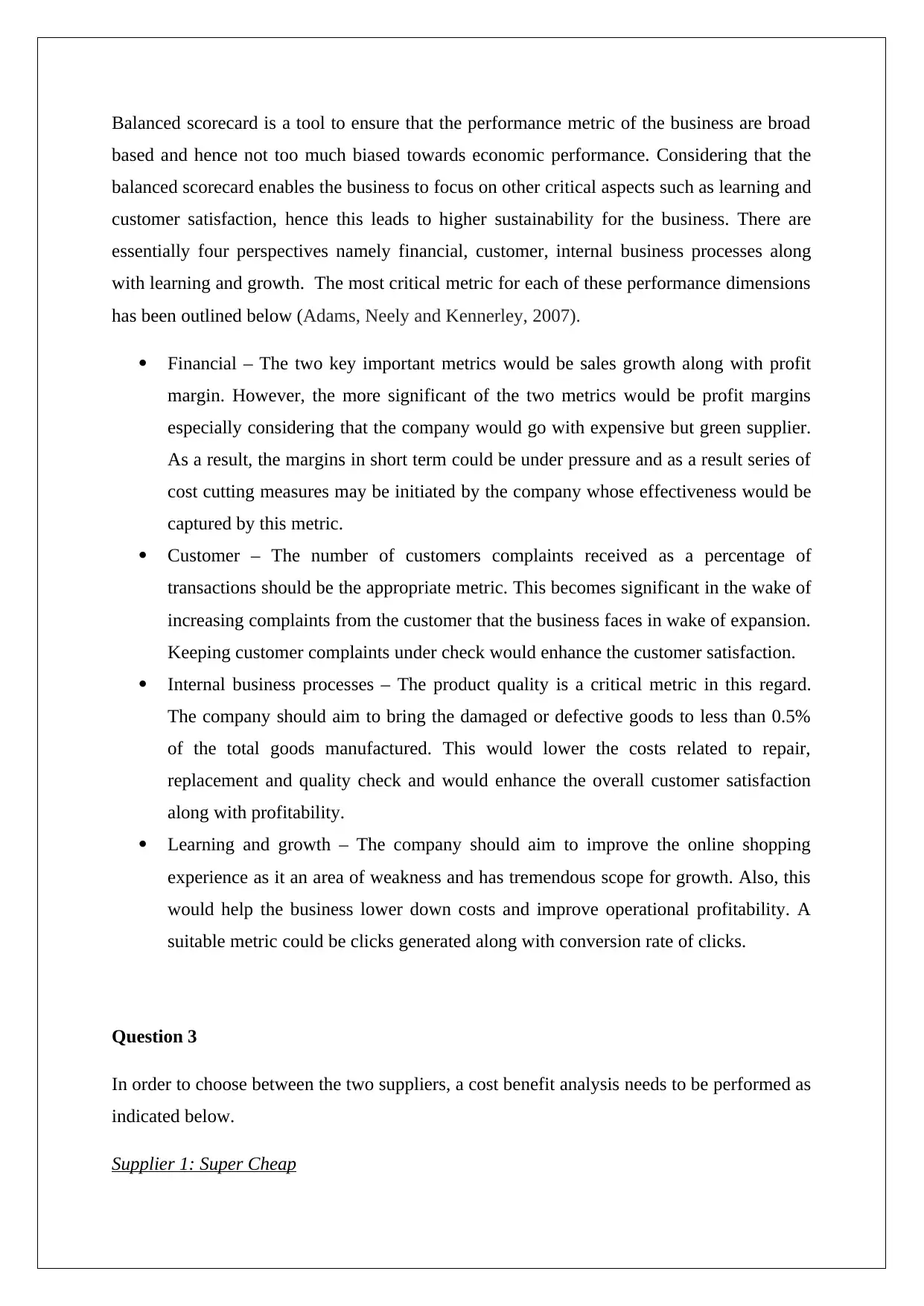
Balanced scorecard is a tool to ensure that the performance metric of the business are broad
based and hence not too much biased towards economic performance. Considering that the
balanced scorecard enables the business to focus on other critical aspects such as learning and
customer satisfaction, hence this leads to higher sustainability for the business. There are
essentially four perspectives namely financial, customer, internal business processes along
with learning and growth. The most critical metric for each of these performance dimensions
has been outlined below (Adams, Neely and Kennerley, 2007).
Financial – The two key important metrics would be sales growth along with profit
margin. However, the more significant of the two metrics would be profit margins
especially considering that the company would go with expensive but green supplier.
As a result, the margins in short term could be under pressure and as a result series of
cost cutting measures may be initiated by the company whose effectiveness would be
captured by this metric.
Customer – The number of customers complaints received as a percentage of
transactions should be the appropriate metric. This becomes significant in the wake of
increasing complaints from the customer that the business faces in wake of expansion.
Keeping customer complaints under check would enhance the customer satisfaction.
Internal business processes – The product quality is a critical metric in this regard.
The company should aim to bring the damaged or defective goods to less than 0.5%
of the total goods manufactured. This would lower the costs related to repair,
replacement and quality check and would enhance the overall customer satisfaction
along with profitability.
Learning and growth – The company should aim to improve the online shopping
experience as it an area of weakness and has tremendous scope for growth. Also, this
would help the business lower down costs and improve operational profitability. A
suitable metric could be clicks generated along with conversion rate of clicks.
Question 3
In order to choose between the two suppliers, a cost benefit analysis needs to be performed as
indicated below.
Supplier 1: Super Cheap
based and hence not too much biased towards economic performance. Considering that the
balanced scorecard enables the business to focus on other critical aspects such as learning and
customer satisfaction, hence this leads to higher sustainability for the business. There are
essentially four perspectives namely financial, customer, internal business processes along
with learning and growth. The most critical metric for each of these performance dimensions
has been outlined below (Adams, Neely and Kennerley, 2007).
Financial – The two key important metrics would be sales growth along with profit
margin. However, the more significant of the two metrics would be profit margins
especially considering that the company would go with expensive but green supplier.
As a result, the margins in short term could be under pressure and as a result series of
cost cutting measures may be initiated by the company whose effectiveness would be
captured by this metric.
Customer – The number of customers complaints received as a percentage of
transactions should be the appropriate metric. This becomes significant in the wake of
increasing complaints from the customer that the business faces in wake of expansion.
Keeping customer complaints under check would enhance the customer satisfaction.
Internal business processes – The product quality is a critical metric in this regard.
The company should aim to bring the damaged or defective goods to less than 0.5%
of the total goods manufactured. This would lower the costs related to repair,
replacement and quality check and would enhance the overall customer satisfaction
along with profitability.
Learning and growth – The company should aim to improve the online shopping
experience as it an area of weakness and has tremendous scope for growth. Also, this
would help the business lower down costs and improve operational profitability. A
suitable metric could be clicks generated along with conversion rate of clicks.
Question 3
In order to choose between the two suppliers, a cost benefit analysis needs to be performed as
indicated below.
Supplier 1: Super Cheap
⊘ This is a preview!⊘
Do you want full access?
Subscribe today to unlock all pages.

Trusted by 1+ million students worldwide
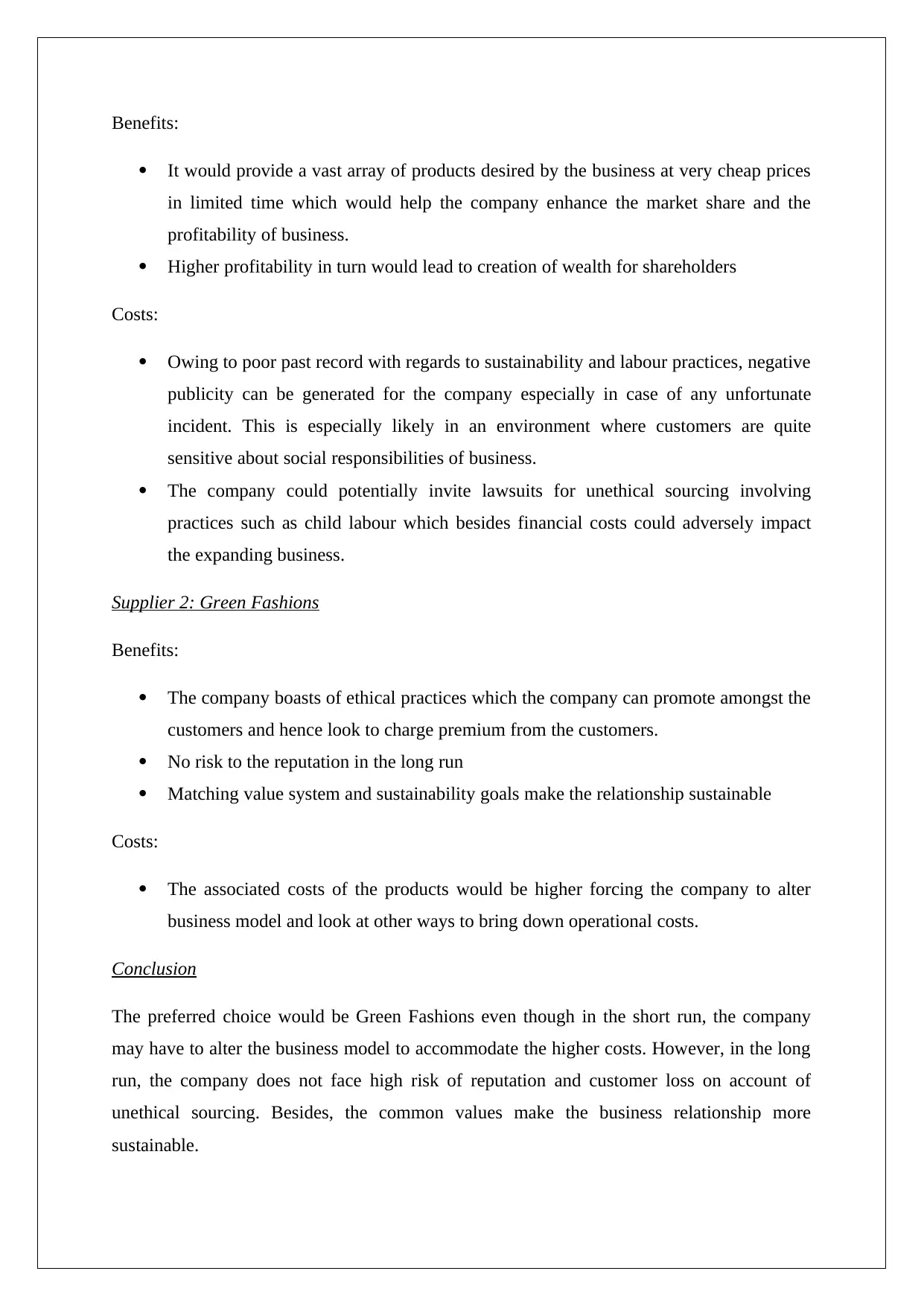
Benefits:
It would provide a vast array of products desired by the business at very cheap prices
in limited time which would help the company enhance the market share and the
profitability of business.
Higher profitability in turn would lead to creation of wealth for shareholders
Costs:
Owing to poor past record with regards to sustainability and labour practices, negative
publicity can be generated for the company especially in case of any unfortunate
incident. This is especially likely in an environment where customers are quite
sensitive about social responsibilities of business.
The company could potentially invite lawsuits for unethical sourcing involving
practices such as child labour which besides financial costs could adversely impact
the expanding business.
Supplier 2: Green Fashions
Benefits:
The company boasts of ethical practices which the company can promote amongst the
customers and hence look to charge premium from the customers.
No risk to the reputation in the long run
Matching value system and sustainability goals make the relationship sustainable
Costs:
The associated costs of the products would be higher forcing the company to alter
business model and look at other ways to bring down operational costs.
Conclusion
The preferred choice would be Green Fashions even though in the short run, the company
may have to alter the business model to accommodate the higher costs. However, in the long
run, the company does not face high risk of reputation and customer loss on account of
unethical sourcing. Besides, the common values make the business relationship more
sustainable.
It would provide a vast array of products desired by the business at very cheap prices
in limited time which would help the company enhance the market share and the
profitability of business.
Higher profitability in turn would lead to creation of wealth for shareholders
Costs:
Owing to poor past record with regards to sustainability and labour practices, negative
publicity can be generated for the company especially in case of any unfortunate
incident. This is especially likely in an environment where customers are quite
sensitive about social responsibilities of business.
The company could potentially invite lawsuits for unethical sourcing involving
practices such as child labour which besides financial costs could adversely impact
the expanding business.
Supplier 2: Green Fashions
Benefits:
The company boasts of ethical practices which the company can promote amongst the
customers and hence look to charge premium from the customers.
No risk to the reputation in the long run
Matching value system and sustainability goals make the relationship sustainable
Costs:
The associated costs of the products would be higher forcing the company to alter
business model and look at other ways to bring down operational costs.
Conclusion
The preferred choice would be Green Fashions even though in the short run, the company
may have to alter the business model to accommodate the higher costs. However, in the long
run, the company does not face high risk of reputation and customer loss on account of
unethical sourcing. Besides, the common values make the business relationship more
sustainable.
Paraphrase This Document
Need a fresh take? Get an instant paraphrase of this document with our AI Paraphraser

Question 4
The various stages of the LCA are highlighted below (Finnveden et. al., 2009).
The two stages which have been chosen for this analysis are inventory analysis and impact
assessment. In inventory analysis, the focus is on the inputs and the outputs generated. The
impact assessment focuses on the effect related to the use of resource and related emissions
and classifying the same in different categories of impact (Crawford, 2011).
The product can be chosen as a T-shirt. The various social and environment impacts are
outlined below (Finnveden et. al., 2009).
In case of unethical sourcing (i.e. by choosing suppliers such as Super Cheap), the
environment would be damages severely owing to the discharge of the untreated
waste directly into rivers. In order to mitigate the same, the company should choose a
supplier which minimises waste generation or disposes the same in a responsible
manner.
Further, pollution of the river could have severe environmental consequences to the
marine life which is apparent from Super Cheap practices. In order to mitigate this, it
becomes necessary that supplier should comply with environmental norms and ensure
that the marine life is not adversely impacted.
There are adverse social consequences with regards to various settlements near the
polluted water bodies owing to the manufacturing of T-shirts. As a result, they might
be required to migrate to another place where drinking water is available. In order to
The various stages of the LCA are highlighted below (Finnveden et. al., 2009).
The two stages which have been chosen for this analysis are inventory analysis and impact
assessment. In inventory analysis, the focus is on the inputs and the outputs generated. The
impact assessment focuses on the effect related to the use of resource and related emissions
and classifying the same in different categories of impact (Crawford, 2011).
The product can be chosen as a T-shirt. The various social and environment impacts are
outlined below (Finnveden et. al., 2009).
In case of unethical sourcing (i.e. by choosing suppliers such as Super Cheap), the
environment would be damages severely owing to the discharge of the untreated
waste directly into rivers. In order to mitigate the same, the company should choose a
supplier which minimises waste generation or disposes the same in a responsible
manner.
Further, pollution of the river could have severe environmental consequences to the
marine life which is apparent from Super Cheap practices. In order to mitigate this, it
becomes necessary that supplier should comply with environmental norms and ensure
that the marine life is not adversely impacted.
There are adverse social consequences with regards to various settlements near the
polluted water bodies owing to the manufacturing of T-shirts. As a result, they might
be required to migrate to another place where drinking water is available. In order to

reduce this undesirable effect, the dumping of waste and pollutants in rivers should
not be practiced and only such suppliers should be entertained.
Further, it is quite possible that these t shirts are produced using child labourers who
are employed in sweat shops. This leads to their exploitation and hampers their
education growth. For mitigation, it is imperative that a supplier should be chosen that
does not use child labour so that this social menace can be discouraged.
Question 5
The clothing industry in the west (whether be it US or UK) is an example of industry which
can improve and act in the interest of the majority shareholders so as to create wealth for
them in the long run. A key practice which is followed by major players in this industry is
outsourcing their cloth manufacturing to South East Asian countries which happen to be
major textile manufacturers. One of the key reasons for this outsourcing is the lure of lower
costs owing to availability of cheap labour. However, the sub-contractors and contractors in
these countries in a bid to further lower costs tend to deploy a sizable amount of child labour.
It is estimated by the ILO (International Labour Organisation) that about 170 million children
across Asia work as child labour with a predominant share being concentrated in the garment
industry (Moulds, 2016).
Considering the complexity of the global supply chains, at times the big brands are not aware
of such practices at the site of contractor. However, there have been instances in the past
when despite being aware of such practices, no concrete action has been taken in order to
safeguard their own interest of maximising profitability. However, this goal is not achieved
as has been seen from the experience of Nike and Adidas which have faced tremendous
implications for running sweat shops for manufacturing of shoes. It is essential that the
clothing industry takes a clue from their experience and understand that in the long run,
wealth can be generated for the majority shareholders only through sustainable and ethical
business practices (Hymann, 2017). Going forward, it is expected that this practice would
tend to diminish which would auger well for the cloth industry in the west despite some
hiccups on the cost side.
not be practiced and only such suppliers should be entertained.
Further, it is quite possible that these t shirts are produced using child labourers who
are employed in sweat shops. This leads to their exploitation and hampers their
education growth. For mitigation, it is imperative that a supplier should be chosen that
does not use child labour so that this social menace can be discouraged.
Question 5
The clothing industry in the west (whether be it US or UK) is an example of industry which
can improve and act in the interest of the majority shareholders so as to create wealth for
them in the long run. A key practice which is followed by major players in this industry is
outsourcing their cloth manufacturing to South East Asian countries which happen to be
major textile manufacturers. One of the key reasons for this outsourcing is the lure of lower
costs owing to availability of cheap labour. However, the sub-contractors and contractors in
these countries in a bid to further lower costs tend to deploy a sizable amount of child labour.
It is estimated by the ILO (International Labour Organisation) that about 170 million children
across Asia work as child labour with a predominant share being concentrated in the garment
industry (Moulds, 2016).
Considering the complexity of the global supply chains, at times the big brands are not aware
of such practices at the site of contractor. However, there have been instances in the past
when despite being aware of such practices, no concrete action has been taken in order to
safeguard their own interest of maximising profitability. However, this goal is not achieved
as has been seen from the experience of Nike and Adidas which have faced tremendous
implications for running sweat shops for manufacturing of shoes. It is essential that the
clothing industry takes a clue from their experience and understand that in the long run,
wealth can be generated for the majority shareholders only through sustainable and ethical
business practices (Hymann, 2017). Going forward, it is expected that this practice would
tend to diminish which would auger well for the cloth industry in the west despite some
hiccups on the cost side.
⊘ This is a preview!⊘
Do you want full access?
Subscribe today to unlock all pages.

Trusted by 1+ million students worldwide
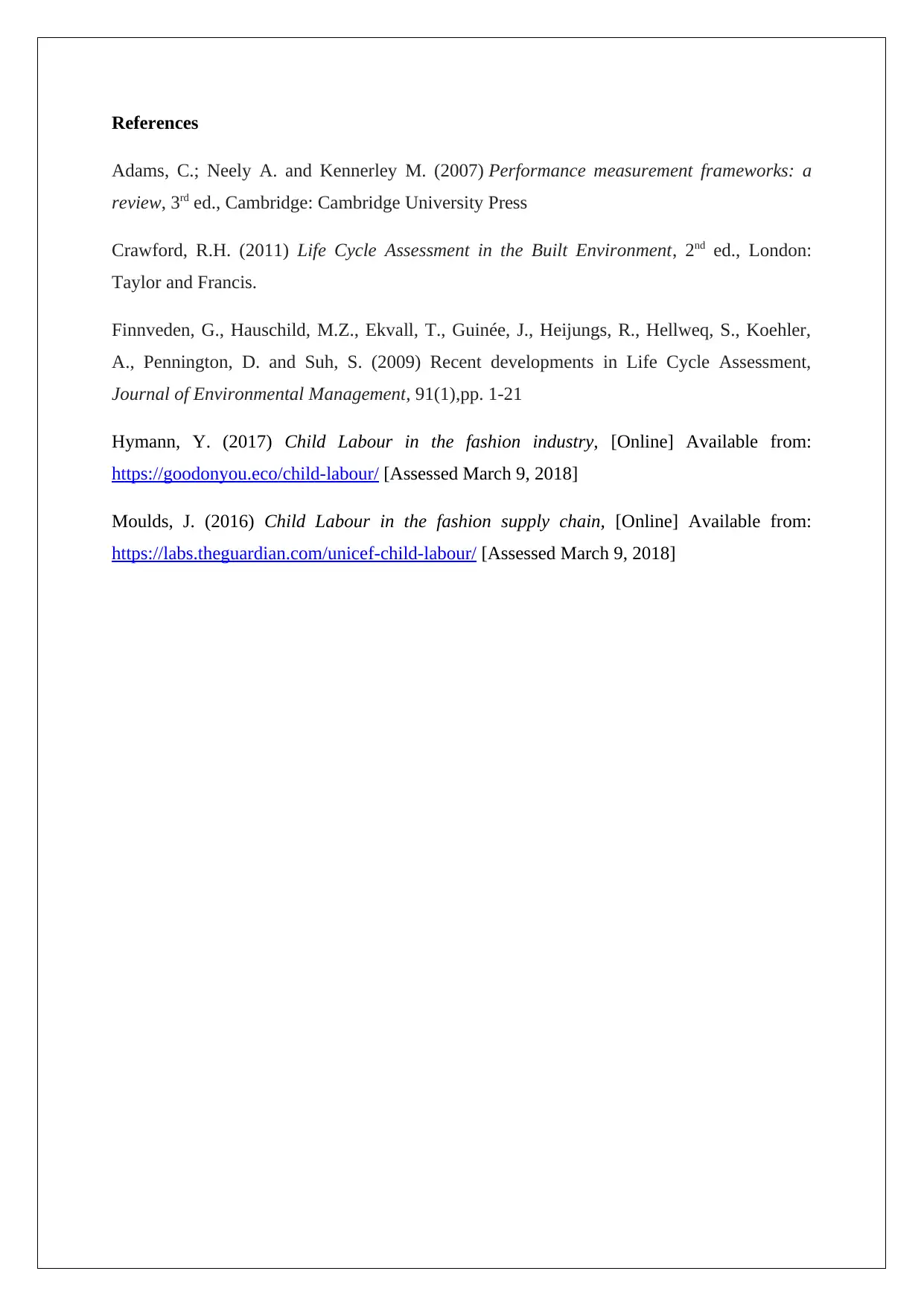
References
Adams, C.; Neely A. and Kennerley M. (2007) Performance measurement frameworks: a
review, 3rd ed., Cambridge: Cambridge University Press
Crawford, R.H. (2011) Life Cycle Assessment in the Built Environment, 2nd ed., London:
Taylor and Francis.
Finnveden, G., Hauschild, M.Z., Ekvall, T., Guinée, J., Heijungs, R., Hellweq, S., Koehler,
A., Pennington, D. and Suh, S. (2009) Recent developments in Life Cycle Assessment,
Journal of Environmental Management, 91(1),pp. 1-21
Hymann, Y. (2017) Child Labour in the fashion industry, [Online] Available from:
https://goodonyou.eco/child-labour/ [Assessed March 9, 2018]
Moulds, J. (2016) Child Labour in the fashion supply chain, [Online] Available from:
https://labs.theguardian.com/unicef-child-labour/ [Assessed March 9, 2018]
Adams, C.; Neely A. and Kennerley M. (2007) Performance measurement frameworks: a
review, 3rd ed., Cambridge: Cambridge University Press
Crawford, R.H. (2011) Life Cycle Assessment in the Built Environment, 2nd ed., London:
Taylor and Francis.
Finnveden, G., Hauschild, M.Z., Ekvall, T., Guinée, J., Heijungs, R., Hellweq, S., Koehler,
A., Pennington, D. and Suh, S. (2009) Recent developments in Life Cycle Assessment,
Journal of Environmental Management, 91(1),pp. 1-21
Hymann, Y. (2017) Child Labour in the fashion industry, [Online] Available from:
https://goodonyou.eco/child-labour/ [Assessed March 9, 2018]
Moulds, J. (2016) Child Labour in the fashion supply chain, [Online] Available from:
https://labs.theguardian.com/unicef-child-labour/ [Assessed March 9, 2018]
1 out of 7
Related Documents
Your All-in-One AI-Powered Toolkit for Academic Success.
+13062052269
info@desklib.com
Available 24*7 on WhatsApp / Email
![[object Object]](/_next/static/media/star-bottom.7253800d.svg)
Unlock your academic potential
Copyright © 2020–2025 A2Z Services. All Rights Reserved. Developed and managed by ZUCOL.





